General characteristics of mushrooms
1. The Kingdom of Mushrooms.
1.1. General characteristics.
Mushrooms are a vast group of organisms, numbering about 100,000 species. They occupy a special position in the system of the organic world, representing, apparently, a special kingdom, along with the kingdoms of animals and plants. They are devoid of chlorophyll and therefore require ready-made organic matter for nutrition (they are called heterotrophic). By the presence in the metabolism of urea, chitin in the cell membrane, a reserve product - glycogen, and not starch - they approach animals. On the other hand, in the way they feed by absorption (adsorptive nutrition), and not by swallowing food, in unlimited growth they resemble plants.
Mushrooms are very diverse in appearance, habitats and physiological functions. However, they also have common features. The basis of the vegetative body of fungi is mycelium, or mycelium, which is a system of thin branching filaments, or hyphae, located on the surface of the substrate where the fungus lives, or inside it. Usually mycelium is very abundant, with a large total surface. Through it, food is absorbed by osmosis. In fungi, conditionally called lower, the mycelium does not have partitions (non-cellular); in some, the body is a naked protoplast; in the rest, the mycelium is divided into cells.
1.1.1. Mushroom cell.
The fungal cell is mostly covered with a hard shell - the cell wall. It is absent in zoospores and the vegetative body of some protozoan fungi. Inside the cell wall is the cytoplasmic membrane surrounding the inner part of the cell - the protoplast (Fig. 1).
The cell wall is 80-90% composed of nitrogen-containing and nitrogen-free polysaccharides. In addition, it contains a small amount of proteins, lipids and polyphosphates. In most fungi, the main polysaccharide is chitin, while in oomycetes it is cellulose.
The cytoplasm of the fungus contains structural proteins and enzymes, amino acids, carbohydrates, and lipids not associated with cell organelles. There are organelles in the fungal cell: mitochondria (mostly similar to those in higher plants), lysosomes with proteolytic enzymes that break down proteins. In the fungal cell there are vacuoles containing reserve nutrients - volutin, lipids, glycogen, as well as fats, mainly unsaturated fatty acids. There is no starch.
A mushroom cell has from one to several nuclei. The nucleus has a double membrane, a nucleolus, and chromosomes containing deoxyribonucleic acid (DNA).
1.1.2. Mushroom mycelium.
The hyphae from which the mycelium is formed have apical growth and branch profusely. Their branches are the younger, the closer they are to the growing top. During the formation of sporulation organs, and often in vegetative organs, fungal filaments are tightly intertwined, forming a false tissue, or plectenchyma (Fig. 2). It differs from real fabric in its origin. The false tissue of fungi is formed by interlacing the threads of the mycelium, and in higher plants - as a result of cell division in all directions. Under a microscope, the plectenchyma often resembles a normal parenchyma, and sometimes a certain differentiation into covering, conducting, etc. is observed in it.
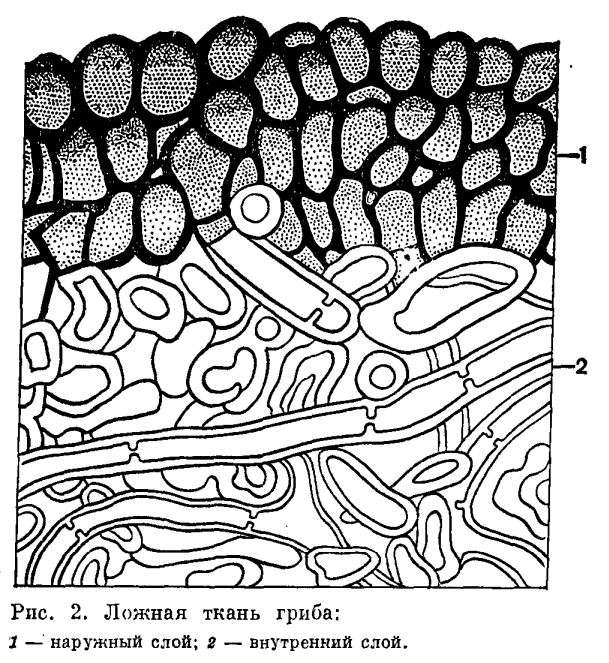
As indicated, most chytrid fungi lack mycelium, and then their body is represented by a naked protoplast. In other chytrids, as well as in oomycetes, most of the zygomycetes, it is devoid of partitions, although sometimes it reaches large sizes, representing, in essence, one giant cell with many nuclei. In other fungi, mycelial hyphae have transverse septa dividing them into cells, often multinucleated.
Parallel connection of hyphae forms mycelial strands, clearly visible at the base of large fruiting bodies. They carry water and nutrients.
In some mushrooms (especially honey agaric and house mushrooms), the strands are more powerful, they are called rhizomorphs (they reach several meters in length and several millimeters in thickness). In rhizomorphs, the walls of the outer hyphae are dark in color, while the inner hyphae are usually white. The purpose of rhizomorphs is the same as thin strands, and in some cases there are special conductive tubes inside rhizomorphs - wide hyphae, resembling vessels of higher plants.
A special type of modification of the mycelium is represented by sclerotia - dense interweaving of hyphae. Sclerotia are rich in reserve nutrients and help the fungus to endure adverse conditions in winter, during drought, etc. Sclerotia are usually dark, rounded or irregularly shaped on the outside, from very small to 30 cm in diameter. From sclerotia, either mycelium or fruiting organs develop.
1.2. Mushroom reproduction.
Fungi have vegetative, asexual and sexual reproduction.
1.2.1. Vegetative propagation of mushrooms.
Vegetative reproduction can be carried out by separating from the bulk of the mycelium of its parts, which can develop independently. In addition, arthrospores (oidia) and chlamydospores can develop on the mycelium (Fig. 3). Arthrospores are formed as a result of the breakdown of hyphae into separate short cells, each of which gives rise to a new organism. Chlamydospores are formed in much the same way, but they have a thicker dark-colored shell. They tolerate adverse conditions well and germinate most often with mycelium.
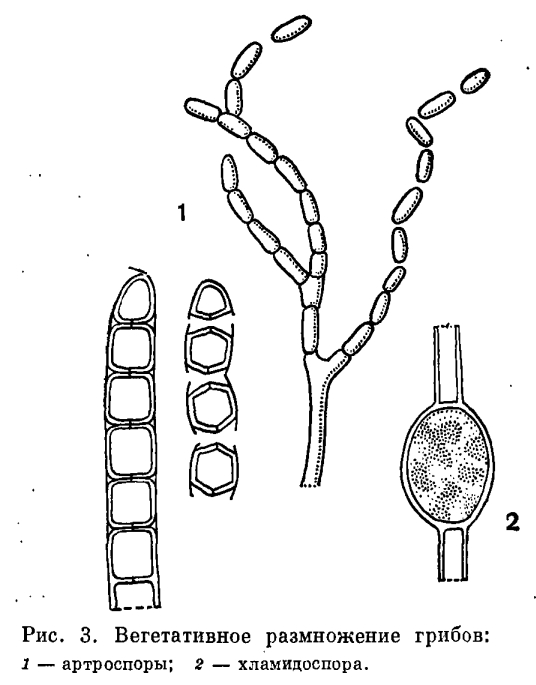
Vegetative propagation is also possible by budding of mycelium or individual cells, for example, in yeast fungi. This process consists in the fact that outgrowths (buds) are formed on the mycelium cells, gradually increasing in size. Such kidneys are separated from the mother cell or remain connected with it, taking the form of peculiar chains. Budding is especially characteristic of yeast fungi, but it also occurs in representatives of other groups. For example, bagospores often bud in golomarshy fungi and basidiospores of some smuts.
1.2.2. Asexual reproduction.
asexual reproduction carried out with the help of special formations called disputes. Spores can develop inside special spore reservoirs (endogenously) or at the ends of special outgrowths of the mycelium - conidiophores (exogenously).
In many lower fungi, asexual reproduction occurs with the help of motile zoospores, equipped with flagella and capable of independent movement in water (Fig. 4).
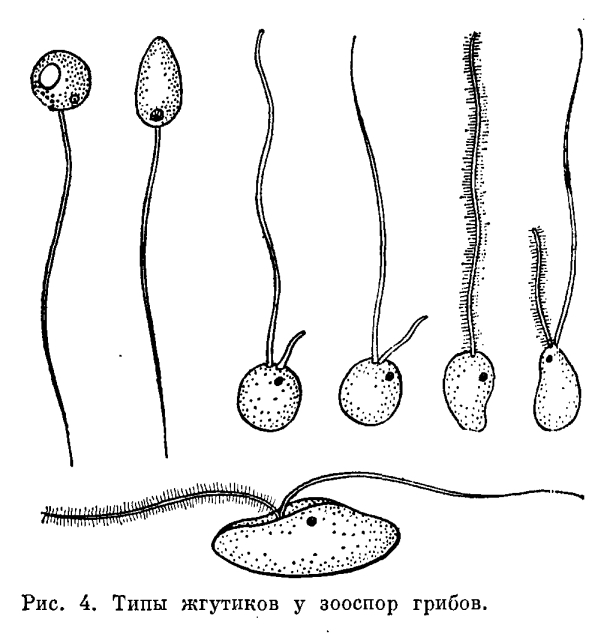
Zoospores develop in zoosporangia. In other lower fungi, spores are devoid of organs of movement, they are formed in sporangia, and the spores themselves are called sporangiospores and. Sporangia sit on special, different from the rest, hyphae - sporangiophores, rising upward from the substrate on which they developed. This arrangement of sporangia facilitates the spread of spores by air currents after they are freed from rupture of the sporangial membrane.
Asexual reproduction with the help of conidia is known in marsupials, basidial, imperfect, and a few lower fungi adapted to terrestrial existence.
Conidia are covered with a shell, they do not have organs of movement (flagella), they are spread by air currents, insects, and humans. By air, conidia can be transported over long distances. There is evidence that spores of the pathogen of wheat stem rust were transferred 1000 km from the source of their mass development.
Conidia differ in the way they form. A description of this process and of the different types of conidia is given in the chapter on imperfect fungi. Their formation occurs on the mycelium or in various kinds of spores (pycnidia bed). When germinating, conidia give a germ tube, and then hyphae.
1.2.3. Sexual reproduction.
sexual reproduction consists in the fusion of male and female gametes, resulting in a zygote. These gametes are haploid, that is, they have a half (unpaired) set of chromosomes. When a zygote is formed, the nuclei merge, the number of chromosomes doubles, and the diploid phase begins with a complete (paired) set of chromosomes. In lower fungi, the sexual process consists in the fusion of motile gametes of the same and different sizes (iso- and heterogamy, respectively) or an oogamous sexual process takes place. In the latter case, female (oogonia) and male (antheridia) reproductive organs develop (Fig. 5). In oogonia, several eggs or one of them develop. Fertilization of the egg occurs either by spermatozoa or by an outgrowth (spur) of the antheridium, which pours its contents into the oogonium. In lower fungi, the reproductive product (oospore) grows into a sporangium. with many controversies in it.
In zygomycete fungi, the sexual process consists in the fusion of two, often outwardly indistinguishable cells at the ends of the mycelium (zygogamy). In many of them, only cells that have different gender signs, conventionally denoted by + or -, can merge, although outwardly they are the same. This phenomenon is called heterothallism (divided cavity). It was discovered in mucosal fungi, and is currently known in fungi from many systematic groups.
In marsupials, the sexual process consists in fertilization by an outgrowth of the antheridium of the female genital organ (archicarp) with contents undifferentiated into eggs. The archicarp is formed from the ascogon. and trichogyne, through which the contents of the antheridium are poured into ascogon. In this case, the male and female nuclei are connected in pairs (but do not merge), forming dikaryons. After fertilization, outgrowths develop from the ascogon - ascogenous hyphae. At their ends, after the fusion of the nuclei (karyogamy), bags, or asci, are formed, and in them bagospores, or ascospores. Before the formation of ascospores, reduction division occurs. Bags in one way or another are enclosed in fruiting bodies - cleistothecia, perithecia, apothecia, pseudothecia. The sexual process in marsupials can go in a different way, but always ends with the formation of a bag.
For basidiomycetes, a sexual process called somatogamy is characteristic. It consists in the fusion of two cells of the vegetative mycelium. The sexual product is the basidium, on which 4 basidiospores are formed, equally with different sex signs. Basidiospores are haploid, they give rise to haploid mycelium, which is short-lived. By the formation of anastomoses between the filaments of the mycelium or in another way, the haploid mycelium merges and the dikaryotic mycelium is formed, on which the formation of basidia with basidiospores occurs.
In imperfect fungi, and in some cases in others, the sexual process is replaced by heterocariosis (diversity) and the parasexual process. In the first case, if there are several often genetically heterogeneous nuclei in the cells, their transition, the nuclei, from one segment of the mycelium to another occurs through the formation of anastomoses or fusion of hyphae (Fig. 5). However, the fusion of nuclei does not occur. The appearance in cells of previously absent nuclei is the basis of adaptive variability.
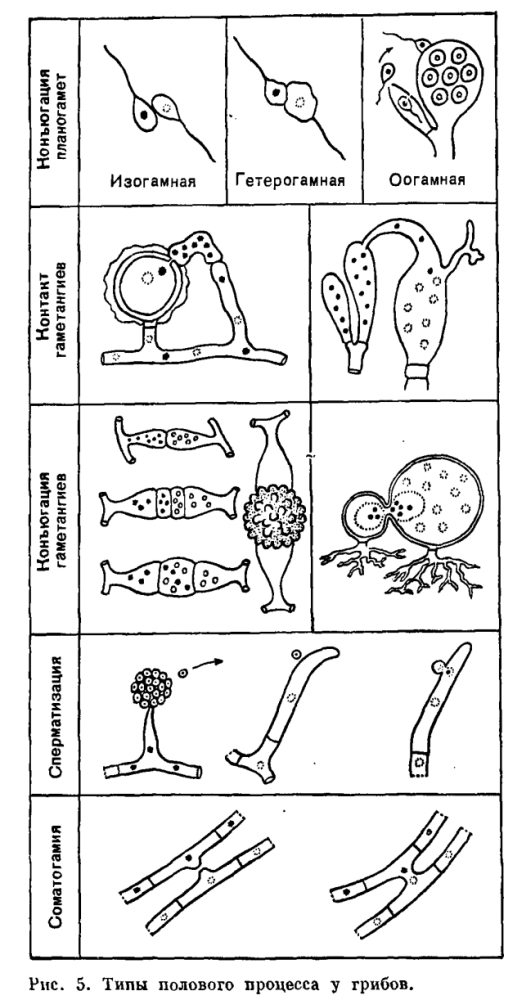
The fusion of nuclei after their transition to another cell is called a parasexual process. The resulting diploid nuclei are able to multiply, and mitotic recombination is possible and, due to this, the restructuring of the genetic material.
In contrast to the vegetative mycelium, which has a very uniform structure, the types of sporulation in fungi are characteristically different.
Often the same fungus can have several sporulations: asexual, of which there are sometimes several, and sexual. Both alternate, following one after the other. The presence of several types of sporulation in the same species of fungus is called pleomorphism. If you do not know the connection between individual sporulations, then each of them can be mistaken for an independent type of fungus. To determine the systematic position of the fungus, sexual sporulation is of primary importance: in lower fungi, the form of the sexual process, the number of flagella of the mobile stage; in higher fungi - the nature of the formation of fruiting bodies, their shape, structure, etc.
1.3. Systematics of mushrooms.
Currently, mushrooms are divided into the following main classes:
Chytridiomycetes(Chytridiomycetes). They do not have mycelium, or their mycelium is rudimentary, underdeveloped. Zoospores and gametes are mobile, uniflagellate. The sexual process is iso-, hetero- and oogamous.
Oomycetes(Oomycetes). The mycelium is well developed, but non-cellular; zoospores with two flagella (one smooth, the other pinnate). The reproductive process is oogamous, the reproductive product is an oospore.
Zygomycetes(Zygomycetes). The mycelium is mostly non-cellular. Sporangiospores (rarely conidia) are immobile. The sexual process is zygogamy.
marsupials, or ascomycetes(Ascomycetes). The mycelium is mostly well developed, often with marsupial and conidial stages. The sexual process is usually gametangiogamy, the reproductive product is bags.
Basidiomycetes(Basidiomycetes). Mycelium developed, cellular. The sexual process is somatogamy, the sexual product is the basidium.
Deuteromycetes, or imperfect fungi(Deuteromycetes). Mycelium developed. Asexual reproduction by conidia, sexual process unknown. The variability of this class of fungi is created by heterokaryosis and the parasexual process.
In addition to these classes, there are small groups of fungi with an unclear systematic position, elevated by some scientists to the rank of a class (for example, trichomycetes).
1.4. Mushroom nutrition.
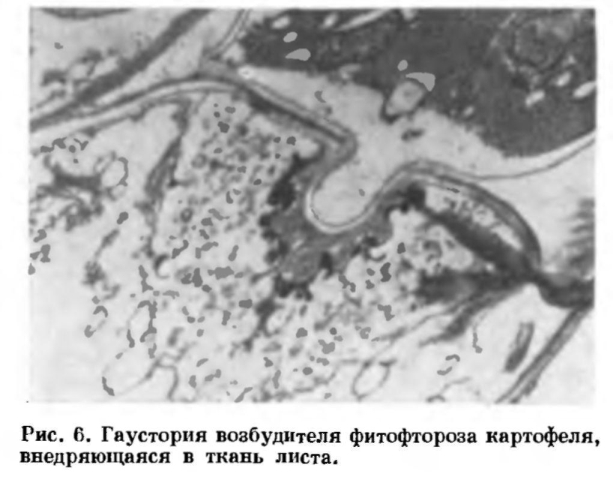
1.5. Ecological groups of fungi.
Fungi are widely distributed in nature on a variety of substrates. In the process of adapting to different living conditions or using various substances or living tissues for nutrition, certain ecological groups of fungi were formed.
A very extensive group of soil fungi, the main habitat of which is the soil. These fungi are involved in the decomposition (mineralization) of organic matter, the formation of humus, etc. Close to them are fungi that destroy the forest floor: fallen leaves, needles. This group includes cap mushrooms - litter saprophytes and some others.
Many soil hymenomycetes are mycorrhiza-forming. In groups of soil fungi, permanent inhabitants of the soil are distinguished - fungi that get there only during a certain period of life (mainly species pathogenic for animals and plants), and fungi - plant rhizospheres living in the zone of their root system.
Predatory mushrooms can live as saprophytes, but are able to catch and feed on nematodes - small roundworms.
The specialized groups of fungi living in the soil include coprophiles that live on soils rich in humus (dung heaps, places of accumulation of animal droppings, etc.); keratinophils confined to life on the hair, horns, and hooves of animals.
A special group is made up of xylophytes - fungi that decompose wood. Among them, there are destroyers of living wood and those that feed on dead wood (fallen branches, logging residues, etc.).
A group of house mushrooms is characteristic - destroyers of wooden parts of buildings.
There are specific ecological groups of fungi that develop on various industrial materials (for example, metal) and products and cause damage to them (biological damage), as well as fungi that live on paper and paper products (books, manuscripts, etc.).
1.6. Origin of mushrooms.

Modern forms of mushrooms appeared a very long time ago. In any case, fungal spores resembling some modern species are found in the deposits of the most ancient geological epochs. So, in the deposits of the Mesozoic (185-70 million years ago), the remains of fungi close to saprolegnium (Fig. 7.1) and imperfections of the genus Diplodia were found. The marsupial fungus Phragmothyrites locaenica (Fig. 7.2), as well as spores of fungi close to the genera Corineum and Helminthosporium (Fig. 7, 3-4) were found in the Cretaceous deposits (70 million years from the present epoch). Spores very similar to those of modern species of rust fungi from the genus Fragmidium (Fig. 7.5) were found in the Paleogene (70-20 million years ago). Fungal remains and spore imprints are found in brown coals, tertiary coals, and clays in various regions of the former Soviet Union. On the Chukchi Peninsula, in the thickness of pre-glacial deposits, the remains of a fungus fungus close to the modern species Ganoderma applanata, which is currently widespread on living and dead tree trunks, were found.
1.7. The importance of mushrooms in human life.
Mushrooms play an important role in the circulation of substances in nature, in the decomposition of animal and plant remains that enter the soil, the formation of organic matter in the soil, and the increase in soil fertility. Organic residues that enter the soil decompose along with bacteria and actinomycetes, soil microscopic fungi. In addition to increasing soil fertility, the destruction of organic residues helps to cleanse it from the beginnings of pathogenic organisms. The decomposition of the forest litter is carried out by a special group of cap mushrooms - litter saprophytes. These include, for example, many talkers, mycenae, collibia, marasmius and a number of others.
After the swamps are drained, a diverse flora of cap saprophytic fungi develops on the forest litter, gradually mineralizing the forest litter and decomposing the underlying peat layers. Ultimately, this leads to the formation of very fertile soils on the site of former peatlands.
Mushrooms usually rather quickly populate tree debris in the forest and fellings. Wood-staining fungi are the first to settle, capable of further destroying wood. Therefore, mushrooms are an important link in the complex process of decomposition of fallen branches and logging wood.
Many fungi have a rich enzymatic apparatus, and also form a number of physiologically active substances. These properties of mushrooms are widely used by man. Enzymes of a number of fungi are used for various purposes: pectinases - for clarification of fruit juices; cellulases - for the processing of raw materials, roughage, the destruction of paper waste residues; proteases - for the hydrolysis of proteins; amylase - for the hydrolysis of starch, etc. In Vietnam, soy sauces are prepared using the enzymes of some mold fungi.
One of the outstanding achievements of recent times is the discovery of antibiotics. The first antibiotic to be widely used in practice was penicillin, a waste product of one of the penicillin fungi. In medicine, preparations from ergot sclerotia are widely used. Using the black mold fungus (Aspergillus niger), citric acid is produced on an industrial scale.
Mushrooms from the genus Fusarium produce a growth substance - gibberellin, which got its name from the name of their marsupial stage - gibberella fujikuroya. Treatment of plants with gibberellins increases their productivity: the setting of grapes increases, the flowering time of ornamental plants accelerates, grass grows faster on lawns, etc.
From the 16th century the cult of sacred Mexican mushrooms is known, as it was later established, belonging to the genus psilocybe, their intoxicating and narcotic effect. Raw mushrooms eaten by humans cause hallucinations, accompanied by gaiety, excitement, and fantastic visions. Mushrooms from the genus psilocybe are grown in the laboratory, and the substance psilocybin is isolated from them, causing these phenomena. This substance is now synthesized and used in psychotherapy. It turned out that halluciogens are also contained in other mushrooms (red fly agaric, ergot horns, etc.).
Everyone is well aware that the population widely uses cap mushrooms as food, and some of them are specially bred by humans. In many countries, champignon is bred, in some countries of Western Europe - summer mushrooms, in the countries of Southeast Asia - volvariella (herbal champignon). The above is not limited to the benefits of mushrooms.
Mushrooms cause great harm to forestry, affecting both growing trees and commercial wood. According to the Czech mycologist V. Ripachek, wood-destroying fungi on average destroy 10-30% of the harvested wood. Fungi destroy wooden buildings, wooden parts of other buildings (house mushrooms), sleepers, and plywood (Table 3).
![]()
Fungi spoil lubricating oils and other petroleum products, optical products, paint coatings, and cause corrosion of metals. Mushrooms destroy books, using glue, fabrics, paper, leather, paints, threads, that is, all the substances that make up a book, for food. Mushrooms are known to damage works of art, in which they destroy the layer of paints, the ground coating, and therefore the paint layer loosens and peels off (Table 4).

Many fungi are harmful to human and animal health. Mushrooms are known - pathogens of skin diseases, hair, nails (ringworm, scab, various kinds of dermatitis). Fungi infect the lungs, especially in young birds (avian aspergillosis), in some cases they are the cause of chronic sinusitis, human eye diseases, various fish diseases, etc.
Mycotoxicoses are very harmful - diseases of humans and animals associated with poisoning of food and feed with toxins (poisons) of fungi. Eating grain poisoned with Fusarium fungi toxins is the cause of human diseases such as septic tonsillitis and Urov's disease (associated with a violation of the normal growth of bones in children). The use of hay and straw for feeding horses in the 30s, on which the fungus Stachybotrys alternate developed, caused a massive disease and a great death of horses. This disease was called stachybotryotoxicosis (after the fungus - its causative agent).
The harmful activity of fungi in book depositories and museums is very dangerous. L. A. Belyakova indicates that there are up to 200 species of various fungi that are harmful in book depositories. They are capable of destroying from 10 to 60% of paper fibers within three months. There are cases when, as a result of the activity of fungi, the strength of paper decreased by up to 50%. All this can lead to the destruction of very valuable books.
To combat damage to books by fungi, special measures are taken: they organize the correct storage regime, use disinfectants that are part of the glue, etc.
To combat fungi that harm works of art in museums, special chemicals are used to treat both the exhibits themselves and the containers in which they are transported and stored.



